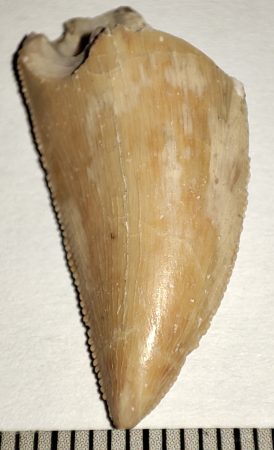- New arrivals
- Products in stock
- Mammuthus fossils [503]
- Megaloceros deer fossils [19]
- Bison Bos fossil [23]
- Rhinoceros fossil [33]
- Echinoderms sea urchin fossil [27]
- Plant wood fossils [38]
- Fish and shark fossils [50]
- Ammonites cephalopods [28]
- Mammalian vertebrates fossils [74]
- Dinosaurus fossil [49]
- Shells fossils [12]
- Gastropods fossils [30]
- Coral fossils [5]
- Trilobites & Crabs fossils [27]
- Minerals [26]
- Insect fossils [19]
- Other Fossils [12]
- Books, literature [10]
Majungasaurus crenatissimus tooth from Madagascar
Cretaceous Period: Partial tooth of a carnivorous dinosaur named Majungasaurus crenatissimus, ca. 70 - 66 million years old. The dinosaur fossil is from the Mahajanga Basin, Madagascar. The tooth measures ca. 28 mm x 13.5 mm x 7 mm. It weighs ca. 3 grams + packaging. The tooth is provided in a ca. 27 mm x 27 mm x 26 mm plastic storage box.
Majungasaurus (its name means 'Mahajanga lizard') is a genus of abelisaurid theropod dinosaurs that lived in Madagascar 70–66 million years ago, during the Cretaceous Period. Only one species, M. crenatissimus, has been identified. Originally described as Majungatholus, the specimen was later found to actually belong to Majungasaurus, so this name became synonymous with Majungasaurus.
Like other abelisaurids, Majungasaurus was a short-snouted, bipedal carnivore. Although its forelimbs are not fully known, they may have been very short, while its hindlimbs were long and stocky. It is distinguished from other abelisaurids by its broad skull with a very rough surface, a cheekbone made of thickened bones on top, and a rounded crest on top (which was initially mistaken for the crown of a pachycephalosaur). Other distinguishing features are the teeth in the lower and upper jaws, which are more numerous than in other abelisaurids.
Majungasaurus is one of the best-known theropod dinosaurs from the Southern Hemisphere, based on its numerous well-preserved skulls and skeletons. It appears to have been more closely related to the abelisaurids of India than to the abelisaurids of South America or Africa, which is important from a biogeographical perspective. As the apex predator of its ecosystem, it preyed mainly on sauropods such as Rapetosaurus, and is the only known dinosaur for which there is direct evidence of cannibalism.
Majungasaurus was a medium-sized theropod, measuring 6–7 m (20–23 ft) long, including its tail. Fragmentary remains of larger specimens suggest that some adults may have been over 8 m (26 ft) long. Scientists estimate the mass of medium-sized adults to be over 1,100 kg (2,300 lb), with the largest specimens likely being heavier.









